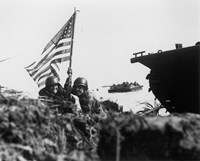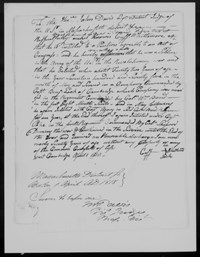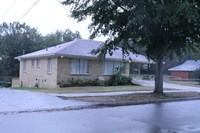- El Camino Real de los Tejas National Historic Trail (42)
- Golden Gate National Recreation Area (29)
- El Camino Real de Tierra Adentro National Historic Trail (28)
- Boston National Historical Park (25)
- Acadia National Park (21)
- Presidio of San Francisco (15)
- Juan Bautista de Anza National Historic Trail (14)
- Tumacácori National Historical Park (11)
- Santa Fe National Historic Trail (10)
- Show More ...
- Geologic Resources Division (9)
- Archeology Program (7)
- National Center for Preservation Technology and Training (6)
- Technical Preservation Services (6)
- National Register of Historic Places Program (5)
- Heritage Documentation Programs (3)
- National Historic Landmarks Program (3)
- Communications (2)
- Inventory and Monitoring Division (2)
- Show More ...
Showing 436 results for Destroyers ...
Xunaa Shuká Hít (Huna Ancestors' House)
Assan/Asan Beach
- Type: Place

During the Japanese occupation of Guam, CHamoru were forced to build defenses on the beach, including the pillboxes and bunkers that can still be seen today, in preparation for the American invasion. That invasion came on July 21, 1944, W Day for Guam. While a simultaneous attack took place five miles south at Hågat, the Third Marine Division landed on the 2,500-yard Assan Beach, marking the start of the Battle of Guam.
Pollinator Garden
- Type: Article

Fort Des Moines is a military installation in Des Moines, Iowa. During World War I, the fort served as the first and only training site for African American officers. During World War II, Fort Des Moines was the first training site for the Women’s Army Auxiliary Corps (WAAC) and the Women’s Army Corps (WAC), and the only training site for WAC and WAAC officers.
Joseph James Barnes
- Type: Person

Joseph J. Barnes was born in South Philadelphia, Pennsylvania on April 27, 1917. He enlisted in the Navy on September 23, 1942 as an Apprentice Seaman (AS). After studying to be a machinist at a Service School, Barnes graduated as a fireman 2nd class. In 1943, he reported to destroyer training before joining the crew of the USS Cassin Young. In serving on the Cassin Young, he joined the Pacific front of World War II. Barnes was killed in action from a kamikaze attack.
John James Takacs
- Type: Person

John was one of six children (three boys and three girls) of Stephen and Elizabeth Takacs, who immigrated from Hungary. John grew up in a Bridgeport, Connecticut. In mid-December he arrived in California and on December 31, 1943, he joined the crew of USS Cassin Young (DD-973). Cassin Young was hit by a second kamikaze on July 30, 1945. Forty-five sailors were wounded and 22 were killed. WT2c(T) John Takacs was one of them.
Jasper Clarence McCartney
- Type: Person

Jasper McCartney spent most of his life at sea, enlisting in the U.S. Navy in 1930 at age 20. In the 1930s, he served on three destroyers, including the USS West Virginia where he worked as a fireman and watertender. In 1940, McCartney joined the crew of the USS Arkansas and was promoted to chief watertender. He was assigned to the USS Cassin Young a few days after its commissioning in December, 1943. McCartney was killed in action during a kamikaze attack on the destroyer.
Clyde Milton Reasoner
- Type: Person

Clyde Reasoner enlisted in the Navy on November 14, 1944. His mother signed a consent form, because he was only 17 years old. Reasoner reported for duty aboard USS Cassin Young (DD-793) on April 26, 1945. In the early morning hours of July 30, 1945, Cassin Young was hit by a kamikaze for a second time. At 18 years old, Clyde Reasoner was the youngest sailor aboard Cassin Young to die in action.
- Type: Article

From July 1775 through April 1776, General George Washington used the abandoned Vassall House in Cambridge as his military headquarters during the Siege of Boston. In order to organize, administer, and command the army, Washington relied on his council of war, comprised of the senior-ranking general officers, and his "military family," comprised of the staff of secretaries and aides de camp at headquarters.
- Type: Person

A lawyer and influential secretary to George Washington, Robert Harrison helped manage the paperwork and communication for Continental Army during the American Revolutionary War. Despite personal struggles, he left Virginia in the beginning of the war to serve as an aide-de-camp at Washington’s headquarters in Cambridge. Harrison became a trusted and dependable secretary to Washington during the war and went on to become the chief judge of Maryland.
- Type: Place

Edificio Comunidad de Orgullo Gay de Puerto Rico, commonly known as “Casa Orgulllo,” served as the meeting hall for the first official gay/lesbian organization established in Puerto Rico. Founded in 1974, Comunidad de Orgullo Gay was the first organized attempt to confront social, political and legal discrimination against the local LGBTQ community.
Oldfarm: Station Eight
Home of Daisy and L.C. Bates
- Type: Person

John Laurens, born to a wealthy planter family in South Carolina, received a republican education in Switzerland and England. Upon his return to South Carolina to fight in the American Revolution, he radically proposed to recruit slaves as soldiers in return for their freedom. An aide-de-camp to General Washington and later a lieutenant colonel of the Continental Army with a field command, he served bravely in many key battles, only to die in a meaningless skirmish in 1782.
Henry Bakeman
- Type: Person

Henry Bakeman enlisted in April 1781, after British and Mohawk troops had destroyed his home village of Stone Arabia in October 1780. Involved first in carrying packages from one Patriot fort to another, resulting in “many skirmishes with the Indiana & Tories,” by late 1782 Bakeman found himself involved in what would be the last engagement of the Revolutionary War. Disaster awaited them. Bakeman’s story was well-documented through his pension record in 1834.
George Washington Spy Code
Byron A. Smith
- Type: Person

Byron A. Smith served in the US Navy during World War II, voluntarily enlisting as an apprentice seaman (AS) in 1943. Prior to serving in the Navy, Smith worked at the Campbell, Wyant and Cannon Foundry Company in Michigan, a company that provided critical contributions to the defense industry. After completing different training schools, Smith was assigned to the USS Cassin Young. Smith was killed when a kamikaze attacked the destroyer.
Billy Joe Boegen
- Type: Person

Billy Joe Boegen enlisted in the U.S. Navy in 1941. He served on the USS Yorktown, the USS West Virginia, and the USS Salt Lake City before he joined the crew of the USS Cassin Young in 1945. He received the Purple Heart and the Silver Star for his service on the destroyer. When a kamikaze attacked the USS Cassin Young on July 30, 1945, Boegen was fatally wounded and died the following day.







